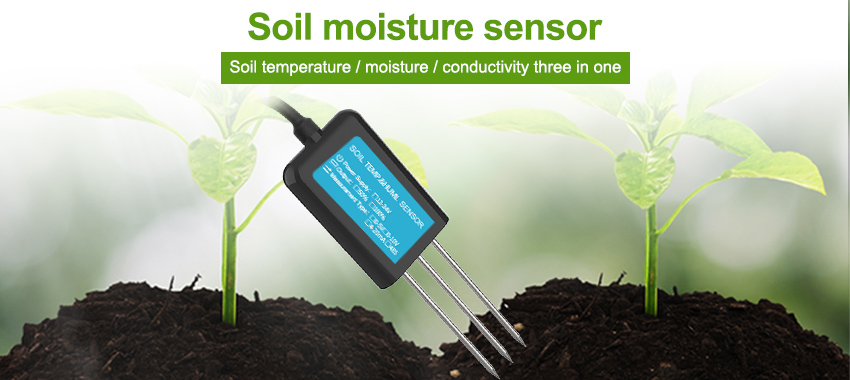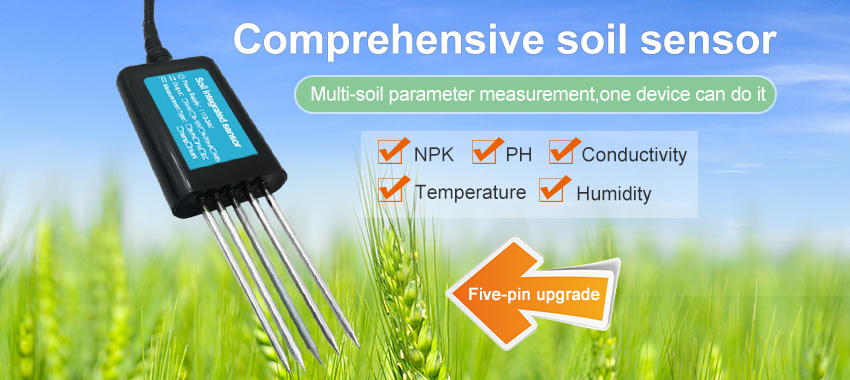The meaning of soil moisture sensor system
Soil moisture sensor system is a physical quantity that represents the degree of soil dryness and moisture in a certain depth of soil, and it is also called soil moisture content. The level of soil moisture is restricted by the various components of farmland moisture balance. The soil moisture sensor system is one of the best ways to detect soil moisture.

Soil moisture sensor system
The soil moisture sensor system is composed of a stainless steel probe and a waterproof probe. It can be buried in the soil and dams for a long time to conduct fixed-point monitoring. And online measurement of the surface and deep soil moisture. Used in conjunction with a data collector, it can be used as a tool for fixed-point water monitoring or mobile measurement to measure soil volumetric water content. It is mainly used for soil moisture detection, agricultural irrigation and forestry protection.
Soil moisture expression method
Soil moisture, that is, the actual soil moisture content, can be expressed as the percentage of soil moisture content in the dry soil weight. Soil moisture content = moisture weight / dry soil weight × 100%. It can also be equivalent to the percentage of soil water content and field water holding capacity. Or relative water content such as the percentage of saturated water content. According to the relative humidity of the soil, we can know the degree of soil moisture and how much water can be retained, which has reference value in irrigation. Soil moisture affects the field climate, soil aeration and nutrient decomposition. And is one of the important conditions for soil microbial activity and crop growth and development.
Soil moisture is affected by conditions such as the atmosphere, soil quality, and vegetation. In the field, the soil moisture is usually judged by hand, and it is generally divided into four levels:

(1) wet, water can flow out of the soil when squeezed by hand;
(2) wet, leaving wet marks on the hand to rub It becomes a soil ball or strip, but no water flows out;
(3) Moist, it feels cool when placed on the hand, leaving a slight mark when pressed by hand;
(4) Dry, there is no cooling sensation on the hand, and the clay becomes a hard lump.
магазин аккаунтов социальных сетей услуги по продаже аккаунтов
купить аккаунт с прокачкой маркетплейс аккаунтов соцсетей
заработок на аккаунтах платформа для покупки аккаунтов
купить аккаунт https://ploshadka-prodazha-akkauntov.ru/
продать аккаунт аккаунт для рекламы
маркетплейс аккаунтов соцсетей купить аккаунт
аккаунт для рекламы магазин аккаунтов
Website for Selling Accounts Website for Buying Accounts
Account Buying Platform Database of Accounts for Sale
Secure Account Sales Database of Accounts for Sale
Purchase Ready-Made Accounts Website for Selling Accounts
Account Selling Service Account exchange
Buy accounts Database of Accounts for Sale
Account Selling Platform Account Purchase
Account marketplace Account Exchange Service
Account Trading Database of Accounts for Sale
Account Trading Service Accounts market
marketplace for ready-made accounts social media account marketplace
secure account purchasing platform account exchange
account store verified accounts for sale
database of accounts for sale secure account sales
buy and sell accounts website for buying accounts
account store secure account sales
gaming account marketplace accounts for sale
profitable account sales gaming account marketplace
accounts for sale account purchase
verified accounts for sale purchase ready-made accounts
sell account profitable account sales
database of accounts for sale website for selling accounts
buy accounts account trading platform
accounts for sale website for selling accounts
account catalog marketplace for ready-made accounts
gaming account marketplace sell account
account marketplace buy pre-made account
buy pre-made account gaming account marketplace
account trading service account selling platform
buy account accounts market
marketplace for ready-made accounts account store
sell account sell accounts
find accounts for sale https://sale-social-accounts.org
account buying service account trading
purchase ready-made accounts accounts for sale
account purchase account exchange
database of accounts for sale account buying service
sell account https://accounts-offer.org/
secure account purchasing platform https://accounts-marketplace.xyz
profitable account sales https://social-accounts-marketplaces.live/
accounts marketplace account marketplace
account selling service https://social-accounts-marketplace.xyz
ready-made accounts for sale https://buy-accounts.space
account marketplace https://buy-accounts-shop.pro
website for buying accounts https://buy-accounts.live/
secure account purchasing platform https://accounts-marketplace.online
buy and sell accounts https://social-accounts-marketplace.live
buy accounts https://accounts-marketplace-best.pro/
маркетплейс аккаунтов соцсетей akkaunty-na-prodazhu.pro
продать аккаунт https://rynok-akkauntov.top/
купить аккаунт https://kupit-akkaunt.xyz/
площадка для продажи аккаунтов https://akkaunt-magazin.online/
площадка для продажи аккаунтов https://akkaunty-market.live/
покупка аккаунтов https://kupit-akkaunty-market.xyz